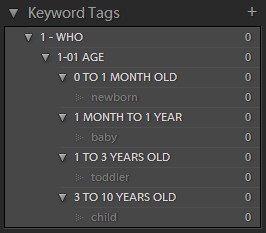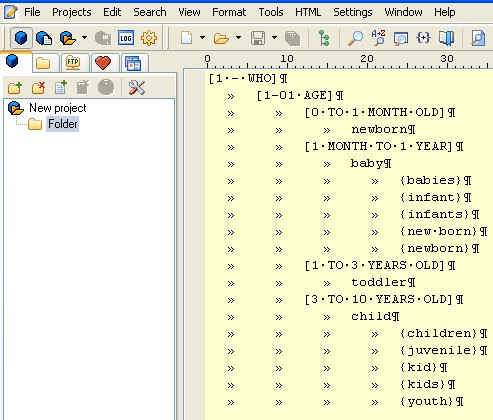Lightroom Keyword List Category Tutorial
- Why are some words not in alphabetical order?
- Why are some words in the list shown in UPPERCASE?
- Why don't some words in the list export to my images?
- Why do some words in the list have numbers?
It takes all sorts to make a world. When some people buy a Keyword List or hierarchical Controlled Vocabulary, they can't wait to open it up in their favorite text-editor program, have a look at what is in there, and maybe tinker about with it a bit, and add things of their own. On the other hand, some people regard anything to do with computers as stuff they won't understand, and even though the Keyword List they have downloaded is helpfully packaged in a '.txt' text file that could be inspected quite easily, they just install it in Lightroom or whichever image management program they are using and assume, quite correctly, that the program will know what to do with it. If you are one of the latter types of people, this tutorial is meant for you.
Categories? Have I got Categories?
So you have installed your keyword list, everything is working, all is fine, but as you start to work with it, you wonder why some words are in alphabetical order, and some aren't. You wonder why some words are all in uppercase. And when you try to export images, you notice that some of the keywords you thought were added to a photograph haven't, in fact, been added after all. The answer to all these points can be summed up in one word: Categories.
Categories are words that are used to order the list of keywords and help you quickly locate the terms that you need, via a logical pathway of helpful signposts. Category words are not normally exported to your images - I'll talk more about that later.
To help you understand the concept of categories, I might suggest now that you take a look at the Keyword List in a text editor, but if you are unhappy digging under the hood, that's fine. You can see some examples of categories just as easily here:
This image shows a list that contains four keywords: 'newborn', 'baby', 'toddler', and 'child'. Imagine, for a moment, those four words in a normal dictionary. How would you locate them if you needed them in a hurry? That is where Category words come in. A thoughtfully-organised keyword list uses Categories to group keywords in a logical and intuitive manner, enabling the user to quickly 'drill-down' to find not only the words that they thought they needed, but also a range of other keywords that are appropriate and helpful for their current keywording task. You can explore how this works by visiting the Keyword Categories page, or you can see what the same list looks like when imported into Lightroom by looking at the image below:

Although category-words perform a useful guiding function in the Keyword List, we do not necessarily want to have them added to the keywords we are using to tag our images with. To differentiate between normal keywords and categories, we enclose all category-words in square brackets [LIKE THIS], which lets Lightroom know the words that are categories and the words that aren't.
Here's a problem, though. Although Lightroom knows which words are categories, it doesn't make much of an effort to let the user know this as well. Here's what Lightroom does:
- Any keywords in your list that are not associated with images are shown in dull text.
- Any keywords in your list that are associated with images are shown in brighter text.
- Category-words are shown in brighter text all the time, whether or not they have any images associated with them, but only if they contain other keywords.
As we can see, the brighter display of categories loses all impact when other keywords are associated with images, and is thus not a lot of help in this respect. In order for the user to be able to identify which words in the Keyword List are normal and which are categories, the general convention adopted by most professionals is to write all Category-words in UPPERCASE. This makes them easy to spot in a long keyword list.
To Export or not to Export?
Once a word or words are enclosed within square brackets, it/they become a Category. As we know, category words in Lightroom will not be exported to your images unless you specifically request that to happen. Here's how to do this:
- On an individual basis, affecting just one keyword category: Right click on the word in question in the left-hand 'Keyword Tags' panel, and an 'Edit Keyword Tag' window will appear. If you add a check to the 'Include on Export' option, then that category will be included with the keywords you are exporting.
- On a global basis, affecting all keyword categories: When you wish to export photos from Lightroom, click 'File > Export'. An 'Export' window will open. In the 'Metatdata' section there is an option 'Write Keywords as Lightroom Hierarchy'. If you check this, then all categories associated with the keywords you are exporting will be included.
Numbers & Alphabetical Ordering
As Category words in Lightroom will not be exported to your images, they can be used for a little more than just signposts. Lightroom always displays a keyword list in alphabetical order, even if it is not formatted that way when you imported it. This can be a little annoying if you prefer you own method of ordering the sections, but there is a simple work-around: use numbers to dictate the way that the list is displayed. In an alphabetical sort, numbers come before letters, so you can add a numerical prefix to a category to force Lightroom to display your Keyword Catalog in a specific order. Visit the Keyword Categories page to see how that is accomplished here.
What about babies & infants?
The keen-eyed among you will have noticed that other words shown in the list above, such as babies, infants, and newborns, have not been mentioned yet. These words are all enclosed in curly-brackets, and are thus defined as 'Synonyms'. To learn all about synonyms, please visit the Keyword List Synonyms page.


